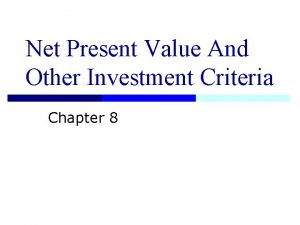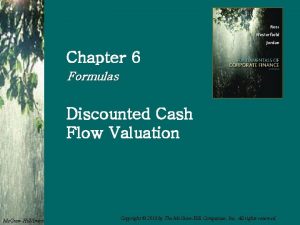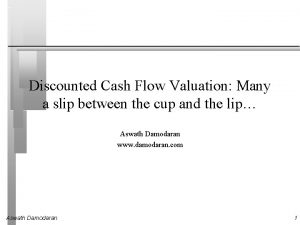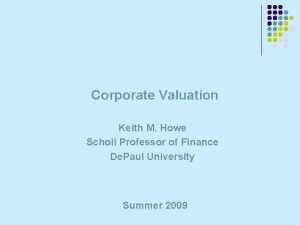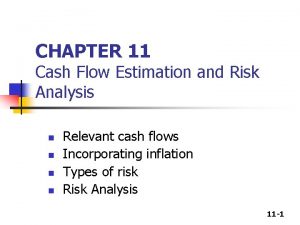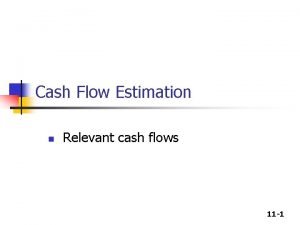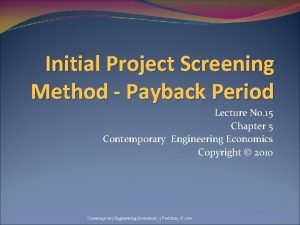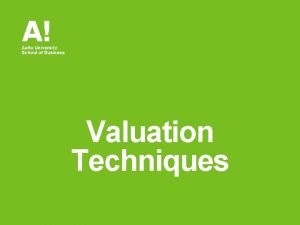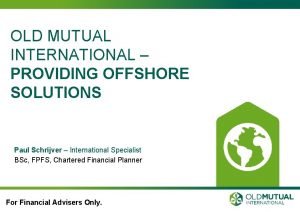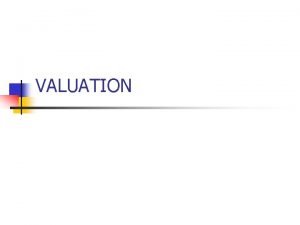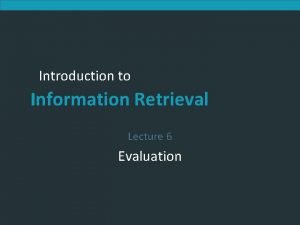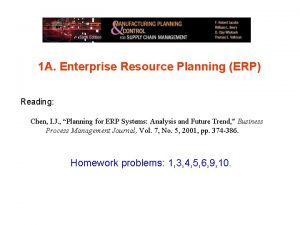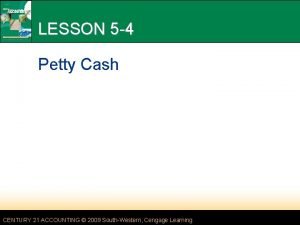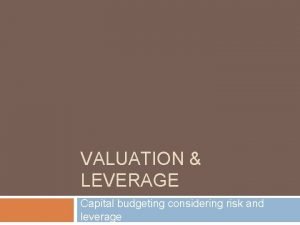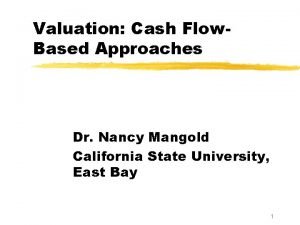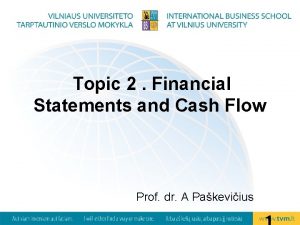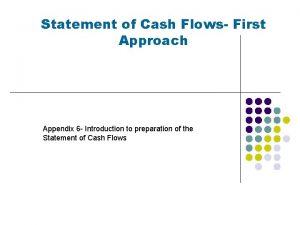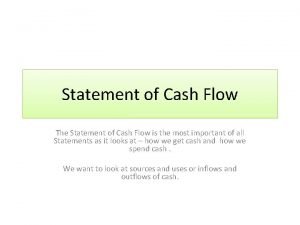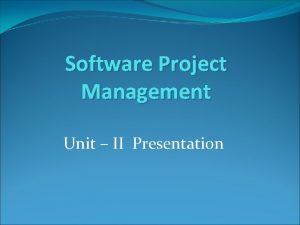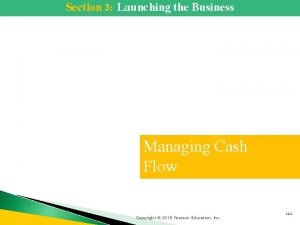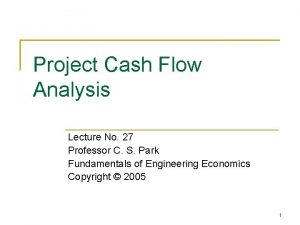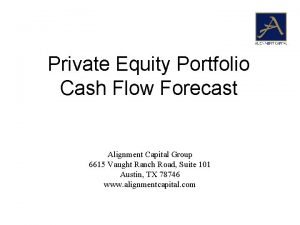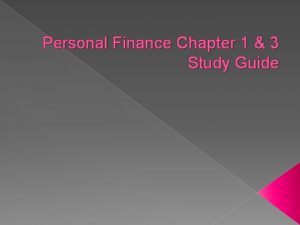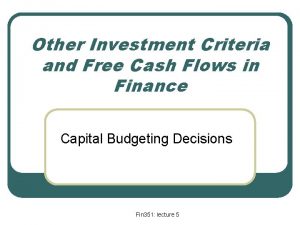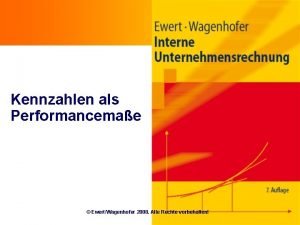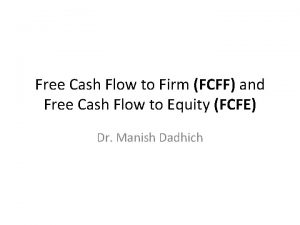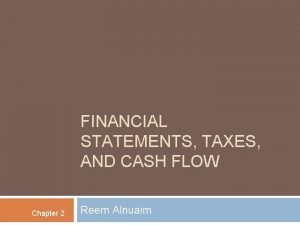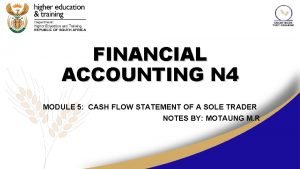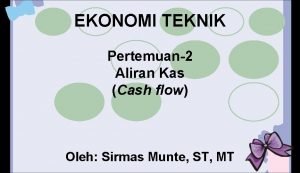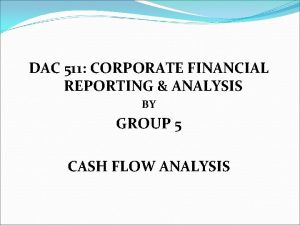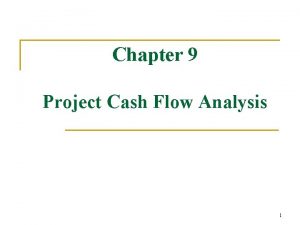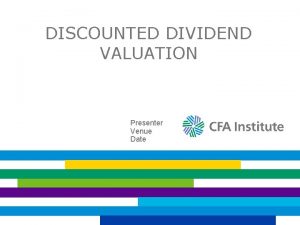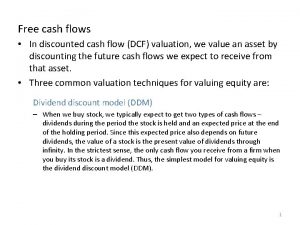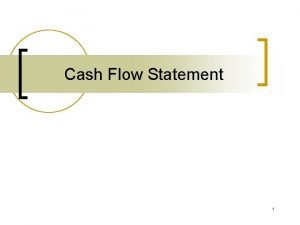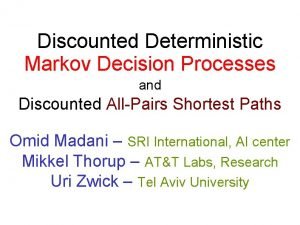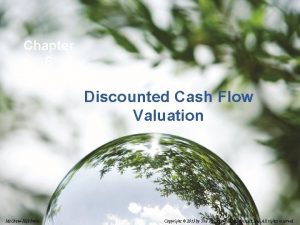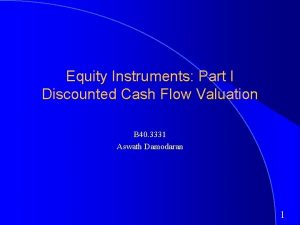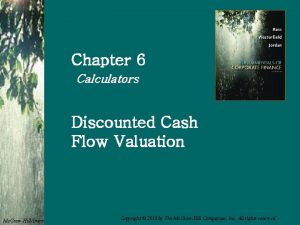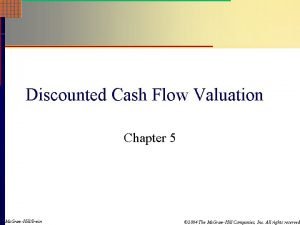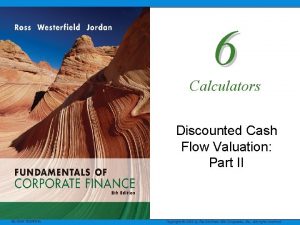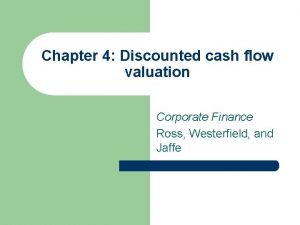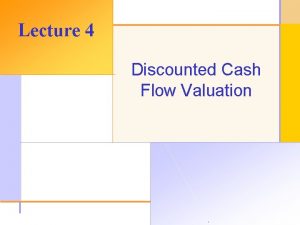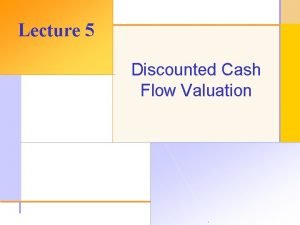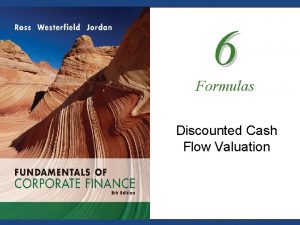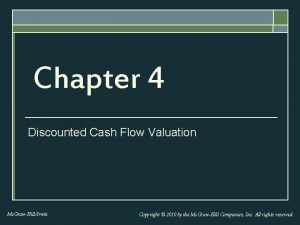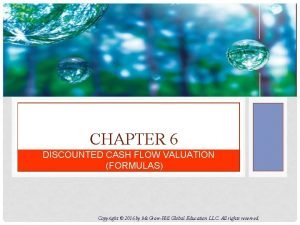DISCOUNTED CASH FLOW Steps in Cash Flow Estimation












































- Slides: 44

DISCOUNTED CASH FLOW

Steps in Cash Flow Estimation • Estimate the current earnings of the firm – If looking at cash flows to equity, look at earnings after interest expenses - i. e. net income – If looking at cash flows to the firm, look at operating earnings after taxes • Consider how much the firm invested to create future growth – If the investment is not expensed, it will be categorized as capital expenditures. To the extent that depreciation provides a cash flow, it will cover some of these expenditures. – Increasing working capital needs are also investments for future growth • If looking at cash flows to equity, consider the cash flows from net debt issues (debt issued - debt repaid)

Measuring Cash Flows

Measuring Cash Flow to the Firm EBIT ( 1 - tax rate) - (Capital Expenditures - Depreciation) - Change in Working Capital = Cash flow to the firm • Where are the tax savings from interest payments in this cash flow?

From Reported to Actual Earnings

I. Update Earnings • When valuing companies, we often depend upon financial statements for inputs on earnings and assets. Annual reports are often outdated and can be updated by using– Trailing 12 -month data, constructed from quarterly earnings reports. – Informal and unofficial news reports, if quarterly reports are unavailable. • Updating makes the most difference for smaller and more volatile firms, as well as for firms that have undergone significant restructuring.

II. Correcting Accounting Earnings • Make sure that there are no financial expenses mixed in with operating expenses – Financial expense: Any commitment that is tax deductible that you have to meet no matter what your operating results: Failure to meet it leads to loss of control of the business. – Example: Operating Leases: While accounting convention treats operating leases as operating expenses, they are really financial expenses and need to be reclassified as such. This has no effect on equity earnings but does change the operating earnings • Make sure that there are no capital expenses mixed in with the operating expenses – Capital expense: Any expense that is expected to generate benefits over multiple periods. – R & D Adjustment: Since R&D is a capital expenditure (rather than an operating expense), the operating income has to be adjusted to reflect its treatment.

R&D Expenses: Operating or Capital Expenses • Accounting standards require us to consider R&D as an operating expense even though it is designed to generate future growth. It is more logical to treat it as capital expenditures. • To capitalize R&D, – Specify an amortizable life for R&D (2 - 10 years) – Collect past R&D expenses for as long as the amortizable life – Sum up the unamortized R&D over the period. (Thus, if the amortizable life is 5 years, the research asset can be obtained by adding up 1/5 th of the R&D expense from five years ago, 2/5 th of the R&D expense from four years ago. . . :

III. One-Time and Non-recurring Charges • Assume that you are valuing a firm that is reporting a loss of $ 500 million, due to a one-time charge of $ 1 billion. What is the earnings you would use in your valuation? A loss of $ 500 million A profit of $ 500 million Would your answer be any different if the firm had reported one-time losses like these once every five years? Yes No

IV. Accounting Malfeasance…. • Though all firms may be governed by the same accounting standards, the fidelity that they show to these standards can vary. More aggressive firms will show higher earnings than more conservative firms. • While you will not be able to catch outright fraud, you should look for warning signals in financial statements and correct for them: – Income from unspecified sources - holdings in other businesses that are not revealed or from special purpose entities. – Income from asset sales or financial transactions (for a nonfinancial firm) – Sudden changes in standard expense items - a big drop in S, G &A or R&D expenses as a percent of revenues, for instance. – Frequent accounting restatements

V. Dealing with Negative or Abnormally Low Earnings

What tax rate? • The tax rate that you should use in computing the after -tax operating income should be The effective tax rate in the financial statements (taxes paid/Taxable income) The tax rate based upon taxes paid and EBIT (taxes paid/EBIT) The marginal tax rate for the country in which the company operates The weighted average marginal tax rate across the countries in which the company operates Any of the above, as long as you compute your aftertax cost of debt using the same tax rate

Net Capital Expenditures • Net capital expenditures represent the difference between capital expenditures and depreciation. Depreciation is a cash inflow that pays for some or a lot (or sometimes all of) the capital expenditures. • In general, the net capital expenditures will be a function of how fast a firm is growing or expecting to grow. High growth firms will have much higher net capital expenditures than low growth firms. • Assumptions about net capital expenditures can therefore never be made independently of assumptions about growth in the future.

Capital expenditures should include • Research and development expenses, once they have been recategorized as capital expenses. The adjusted net cap ex will be Adjusted Net Capital Expenditures = Net Capital Expenditures + Current year’s R&D expenses - Amortization of Research Asset • Acquisitions of other firms, since these are like capital expenditures. The adjusted net cap ex will be Adjusted Net Cap Ex = Net Capital Expenditures + Acquisitions of other firms - Amortization of such acquisitions Two caveats: 1. Most firms do not do acquisitions every year. Hence, a normalized measure of acquisitions (looking at an average over time) should be used 2. The best place to find acquisitions is in the statement of cash flows, usually categorized under other investment activities

Working Capital Investments • In accounting terms, the working capital is the difference between current assets (inventory, cash and accounts receivable) and current liabilities (accounts payables, short term debt and debt due within the next year) • A cleaner definition of working capital from a cash flow perspective is the difference between non-cash current assets (inventory and accounts receivable) and non-debt current liabilities (accounts payable) • Any investment in this measure of working capital ties up cash. Therefore, any increases (decreases) in working capital will reduce (increase) cash flows in that period. • When forecasting future growth, it is important to forecast the effects of such growth on working capital needs, and building these effects into the cash flows.

Working Capital: General Propositions • Changes in non-cash working capital from year to year tend to be volatile. A far better estimate of non-cash working capital needs, looking forward, can be estimated by looking at non-cash working capital as a proportion of revenues • Some firms have negative non-cash working capital. Assuming that this will continue into the future will generate positive cash flows for the firm. While this is indeed feasible for a period of time, it is not forever. Thus, it is better that non-cash working capital needs be set to zero, when it is negative.

Dividends and Cash Flows to Equity • In the strictest sense, the only cash flow that an investor will receive from an equity investment in a publicly traded firm is the dividend that will be paid on the stock. • Actual dividends, however, are set by the managers of the firm and may be much lower than the potential dividends (that could have been paid out) – managers are conservative and try to smooth out dividends – managers like to hold on to cash to meet unforeseen future contingencies and investment opportunities • When actual dividends are less than potential dividends, using a model that focuses only on dividends will under state the true value of the equity in a firm.

Measuring Potential Dividends • Some analysts assume that the earnings of a firm represent its potential dividends. This cannot be true for several reasons: – Earnings are not cash flows, since there are both non-cash revenues and expenses in the earnings calculation – Even if earnings were cash flows, a firm that paid its earnings out as dividends would not be investing in new assets and thus could not grow – Valuation models, where earnings are discounted back to the present, will over estimate the value of the equity in the firm • The potential dividends of a firm are the cash flows left over after the firm has made any “investments” it needs to make to create future growth and net debt repayments (debt repayments - new debt issues) – The common categorization of capital expenditures into discretionary and non-discretionary loses its basis when there is future growth built into the valuation.

Estimating Cash Flows: FCFE • Cash flows to Equity for a Levered Firm Net Income - (Capital Expenditures - Depreciation) - Changes in non-cash Working Capital - (Principal Repayments - New Debt Issues) = Free Cash flow to Equity

Leverage, FCFE and Value • In a discounted cash flow model, increasing the debt/equity ratio will generally increase the expected free cash flows to equity investors over future time periods and also the cost of equity applied in discounting these cash flows. Which of the following statements relating leverage to value would you subscribe to? Increasing leverage will increase value because the cash flow effects will dominate the discount rate effects Increasing leverage will decrease value because the risk effect will be greater than the cash flow effects Increasing leverage will not affect value because the risk effect will exactly offset the cash flow effect Any of the above, depending upon what company you are looking at and where it is in terms of current leverage

Ways of Estimating Growth in Earnings • Look at the past – The historical growth in earnings per share is usually a good starting point for growth estimation • Look at what others are estimating – Analysts estimate growth in earnings per share for many firms. It is useful to know what their estimates are. • Look at fundamentals – Ultimately, all growth in earnings can be traced to two fundamentals - how much the firm is investing in new projects, and what returns these projects are making for the firm.

I. Historical Growth in EPS • Historical growth rates can be estimated in a number of different ways – Arithmetic versus Geometric Averages – Simple versus Regression Models • Historical growth rates can be sensitive to – the period used in the estimation • In using historical growth rates, the following factors have to be considered – how to deal with negative earnings – the effect of changing size

Dealing with Negative Earnings • When the earnings in the starting period are negative, the growth rate cannot be estimated. (0. 30/-0. 05 = -600%) • There are three solutions: – Use the higher of the two numbers as the denominator (0. 30/0. 25 = 120%) – Use the absolute value of earnings in the starting period as the denominator (0. 30/0. 05=600%) – Use a linear regression model and divide the coefficient by the average earnings. • When earnings are negative, the growth rate is meaningless. Thus, while the growth rate can be estimated, it does not tell you much about the future.

II. Analyst Forecasts of Growth • While the job of an analyst is to find under and over valued stocks in the sectors that they follow, a significant proportion of an analyst’s time (outside of selling) is spent forecasting earnings per share. – Most of this time, in turn, is spent forecasting earnings per share in the next earnings report – While many analysts forecast expected growth in earnings per share over the next 5 years, the analysis and information (generally) that goes into this estimate is far more limited.

The Five Deadly Sins of an Analyst • Tunnel Vision: Becoming so focused on the sector and valuations within the sector that you lose sight of the bigger picture. • Lemmingitis: Strong urge felt to change recommendations & revise earnings estimates when other analysts do the same. • Stockholm Syndrome: Refers to analysts who start identifying with the managers of the firms that they are supposed to follow. • Factophobia (generally is coupled with delusions of being a famous story teller): Tendency to base a recommendation on a “story” coupled with a refusal to face the facts. • Dr. Jekyll/Mr. Hyde: Analyst who thinks his primary job is to bring in investment banking business to the firm.

Expected Long Term Growth in EPS • • When looking at growth in earnings per share, these inputs can be cast as follows: Reinvestment Rate = Retained Earnings/ Current Earnings = Retention Ratio Return on Investment = ROE = Net Income/Book Value of Equity In the special case where the current ROE is expected to remain unchanged g. EPS = Retained Earningst-1/ NIt-1 * ROE = Retention Ratio * ROE = b * ROE • Proposition 1: The expected growth rate in earnings for a company cannot exceed its return on equity in the long term.

ROE and Leverage • ROE = ROC + D/E (ROC - i (1 -t)) where, ROC = EBITt (1 - tax rate) / Book value of Capitalt-1 D/E = BV of Debt/ BV of Equity i = Interest Expense on Debt / BV of Debt t = Tax rate on ordinary income • Note that Book value of capital = Book Value of Debt + Book value of Equity.

Expected Growth in Net Income • The limitation of the EPS fundamental growth equation is that it focuses on per share earnings and assumes that reinvested earnings are invested in projects earning the return on equity. • A more general version of expected growth in earnings can be obtained by substituting in the equity reinvestment into real investments (net capital expenditures and working capital): Equity Reinvestment Rate = (Net Capital Expenditures + Change in Working Capital) (1 - Debt Ratio)/ Net Income Expected Growth. Net Income = Equity Reinvestment Rate * ROE

Expected Growth in EBIT And Fundamentals: Stable ROC and Reinvestment Rate • When looking at growth in operating income, the definitions are Reinvestment Rate = (Net Capital Expenditures + Change in WC)/EBIT(1 -t) Return on Investment = ROC = EBIT(1 -t)/(BV of Debt + BV of Equity) • Reinvestment Rate and Return on Capital g. EBIT = (Net Capital Expenditures + Change in WC)/EBIT(1 -t) * ROC = Reinvestment Rate * ROC • Proposition: The net capital expenditure needs of a firm, for a given growth rate, should be inversely proportional to the quality of its investments.

• Estimating Growth when Operating Income is Negative or Margins are changing When operating income is negative or margins are expected to change over time, we use a three step process to estimate growth: – Estimate growth rates in revenues over time • Use historical revenue growth to get estimates of revenue growth in the near future • Decrease the growth rate as the firm becomes larger • Keep track of absolute revenues to make sure that the growth is feasible – Estimate expected operating margins each year • Set a target margin that the firm will move towards • Adjust the current margin towards the target margin – Estimate the capital that needs to be invested to generate revenue growth and expected margins • Estimate a sales to capital ratio that you will use to generate reinvestment needs each year.

Terminval Value… The tail that wags the dog. . Discounted Cashflow Valuation

Getting Closure in Valuation • A publicly traded firm potentially has an infinite life. The value is therefore the present value of cash flows forever. Since we cannot estimate cash flows forever, we estimate cash flows for a “growth period” and then estimate a terminal value, to capture the value at the end of the period:

Ways of Estimating Terminal Value

Stable Growth and Terminal Value • When a firm’s cash flows grow at a “constant” rate forever, the present value of those cash flows can be written as: Value = Expected Cash Flow Next Period / (r - g) where, r = Discount rate (Cost of Equity or Cost of Capital) g = Expected growth rate • This “constant” growth rate is called a stable growth rate and cannot be higher than the growth rate of the economy in which the firm operates. • While companies can maintain high growth rates for extended periods, they will approach “stable growth” at some point in time.

Stable Growth and Excess Returns • Strange though this may seem, the terminal value is not as much a function of stable growth as it is a function of what you assume about excess returns in stable growth. • In the scenario where you assume that a firm earns a return on capital equal to its cost of capital in stable growth, the terminal value will not change as the growth rate changes. • If you assume that your firm will earn positive (negative) excess returns in perpetuity, the terminal value will increase (decrease) as the stable growth rate increases.

Determinants of Growth Patterns • Size of the firm – Success usually makes a firm larger. As firms become larger, it becomes much more difficult for them to maintain high growth rates • Current growth rate – While past growth is not always a reliable indicator of future growth, there is a correlation between current growth and future growth. Thus, a firm growing at 30% currently probably has higher growth and a longer expected growth period than one growing 10% a year now. • Barriers to entry and differential advantages – Ultimately, high growth comes from high project returns, which, in turn, comes from barriers to entry and differential advantages. – The question of how long growth will last and how high it will be can therefore be framed as a question about what the barriers to entry are, how long they will stay up and how strong they will remain.

Stable Growth Characteristics • In stable growth, firms should have the characteristics of other stable growth firms. In particular, – The risk of the firm, as measured by beta and ratings, should reflect that of a stable growth firm. • Beta should move towards one • The cost of debt should reflect the safety of stable firms (BBB or higher) – The debt ratio of the firm might increase to reflect the larger and more stable earnings of these firms. • The debt ratio of the firm might moved to the optimal or an industry average • If the managers of the firm are deeply averse to debt, this may never happen – The reinvestment rate of the firm should reflect the expected growth rate and the firm’s return on capital • Reinvestment Rate = Expected Growth Rate / Return on Capital

Closing Thoughts on Terminal Value • The terminal value will always be a large proportion of the total value. That is a reflection of the reality that the bulk of your returns from holding a stock for a finite period comes from price appreciation. – As growth increases, the proportion of value from terminal value will go up. – The present value of the terminal value can be greater than 100% of the current value of the stock. • The key assumption in the terminal value calculation is not the growth rate but the excess return assumption. • The terminal value, if you follow consistency requirements, is not unbounded.

Which cash flow should I discount? • Use Equity Valuation (a) for firms which have stable leverage, whether high or not, and (b) if equity (stock) is being valued • Use Firm Valuation (a) for firms which have leverage which is too high or too low, and expect to change the leverage over time, because debt payments and issues do not have to be factored in the cash flows and the discount rate (cost of capital) does not change dramatically over time. (b) for firms for which you have partial information on leverage (eg: interest expenses are missing. . ) (c) in all other cases, where you are more interested in valuing the firm than the equity. (Value Consulting? )

Given cash flows to equity, should I discount dividends or FCFE? • Use the Dividend Discount Model – (a) For firms which pay dividends (and repurchase stock) which are close to the Free Cash Flow to Equity (over a extended period) – (b)For firms where FCFE are difficult to estimate (Example: Banks and Financial Service companies) • Use the FCFE Model – (a) For firms which pay dividends which are significantly higher or lower than the Free Cash Flow to Equity. (b) For firms where dividends are not available (Example: Private Companies, IPOs)

What discount rate should I use? • Cost of Equity versus Cost of Capital – If discounting cash flows to equity – If discounting cash flows to the firm -> Cost of Equity -> Cost of Capital • What currency should the discount rate (risk free rate) be in? – Match the currency in which you estimate the risk free rate to the currency of your cash flows • Should I use real or nominal cash flows? – If discounting real cash flows -> real cost of capital – If nominal cash flows -> nominal cost of capital – If inflation is low (<10%), stick with nominal cash flows since taxes are based upon nominal income – If inflation is high (>10%) switch to real cash flows

Which Growth Pattern Should I use? • If your firm is – large and growing at a rate close to or less than growth rate of the economy, or – constrained by regulation from growing at rate faster than the economy – has the characteristics of a stable firm (average risk & reinvestment rates) Use a Stable Growth Model • If your firm – is large & growing at a moderate (≤ Overall growth rate + 10%) or – has a single product & barriers to entry with a finite life (e. g. patents) Use a 2 -Stage Growth Model • If your firm – is small and growing at a very high rate (> Overall growth rate + 10%) or – has significant barriers to entry into the business – has firm characteristics that are very different from the norm Use a 3 -Stage or n-stage Model

The Building Blocks of Valuation

Classifying DCF Models
 Bcr formula
Bcr formula Chapter 6 discounted cash flow valuation
Chapter 6 discounted cash flow valuation Discounted cash flow
Discounted cash flow Discounted cash
Discounted cash Cash flow estimation and risk analysis
Cash flow estimation and risk analysis Relevant cash flows
Relevant cash flows Discounted payback period formula
Discounted payback period formula Payback equation
Payback equation Advantages of capital budgeting
Advantages of capital budgeting Discounted abnormal earnings model
Discounted abnormal earnings model Old mutual wealth discounted gift trust
Old mutual wealth discounted gift trust Discounted rate of return
Discounted rate of return Discounted cumulative gain
Discounted cumulative gain Discounted gift trust
Discounted gift trust Sewage and storm water estimation
Sewage and storm water estimation Cash to cash cycle time
Cash to cash cycle time Cash to cash cycle time
Cash to cash cycle time Cash in cash out example
Cash in cash out example Operating budget example
Operating budget example Paid cash to establish a petty cash fund
Paid cash to establish a petty cash fund Accounting chapter 5 cash control systems answers
Accounting chapter 5 cash control systems answers Acial movement
Acial movement Apv finance
Apv finance Residual cash flow
Residual cash flow Cash flow identity holds
Cash flow identity holds Cash first approach
Cash first approach Salaries paid in cash flow statement
Salaries paid in cash flow statement Cash flow forecasting in software project management
Cash flow forecasting in software project management Discount cash flow method
Discount cash flow method Difference between cash flow and revenue
Difference between cash flow and revenue Cash flow table
Cash flow table Private equity cash flow forecasting
Private equity cash flow forecasting Free cash flow represents
Free cash flow represents A savings option many employers offer is
A savings option many employers offer is Pasqyra e cash flow
Pasqyra e cash flow Pasqyra e rrjedhes se parase
Pasqyra e rrjedhes se parase Incremental cash flows
Incremental cash flows Eva kennzahl
Eva kennzahl Fcff
Fcff Cash flow to creditors
Cash flow to creditors Noncash items refer to
Noncash items refer to Financial accounting mod 5
Financial accounting mod 5 Annual cash flow analysis
Annual cash flow analysis Direct vs indirect cash flow
Direct vs indirect cash flow Project cash flow diagram
Project cash flow diagram
